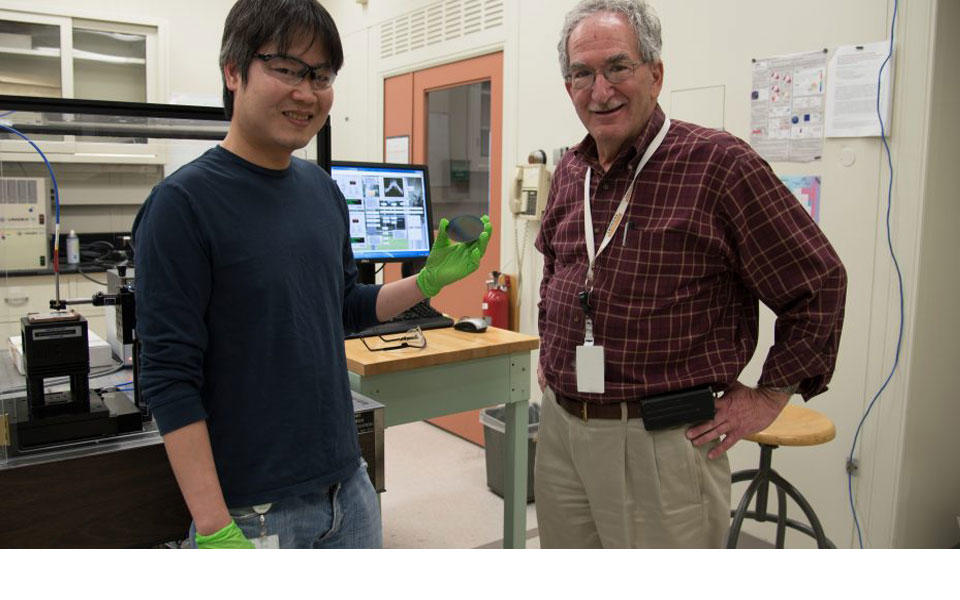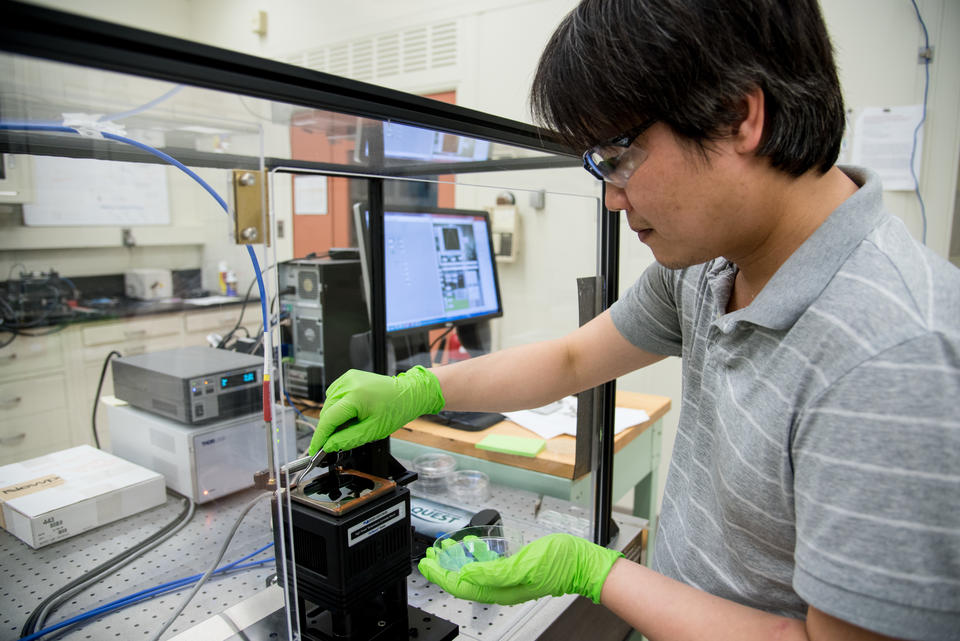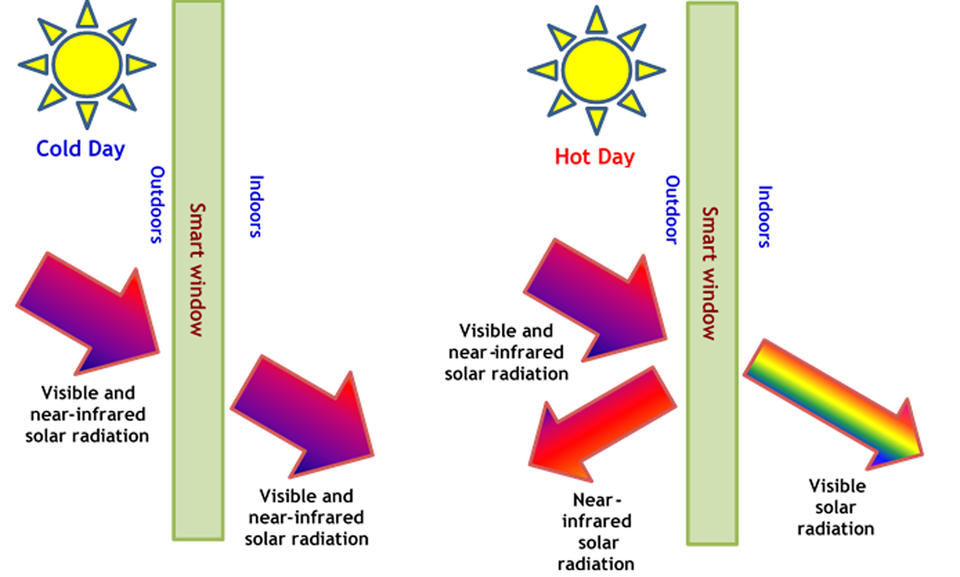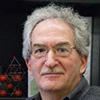Taking Measure
Just a Standard Blog

My colleague NIST researcher Nam Nguyen and I showing off our smart window test wafer.
I think curiosity is at the root of all scientific careers. That, and insecurity. In my formative years, I felt compelled to assign a rational explanation to everything. I didn’t know it then, but I was practicing to be a scientist—and having lots of fun.
I remember entertaining numerous misconceptions. Looking back, I think in many cases the misconceptions made a better story than the truth. For instance, as a child, I thought that when you dropped a letter into the mailbox on the corner, it was delivered to the correct address through one of a multitude of underground channels connecting all mailboxes to all residences.

Then I grew up a little. It’s definitely more fun making things up, but it’s hard to succeed in school if you do too much of that. I was always interested in how things worked, from record players to TVs and clouds to frogs. I had a wide range of interests, but I liked performing chemistry experiments with my older brother the most. (In the 1960s, you could buy “Gilbert” chemistry sets at Macy’s that contained chemicals whose possession today would lead to incarceration.)
In high school, I continued my chemistry studies. When one of my teachers taught a unit on metallurgy, I was fascinated to learn how humans make engineered structures from raw materials. I realized that metals and materials are fundamental to human civilization. After all, didn’t we name eras of human development after the most sophisticated materials on hand: stone → bronze → iron → silicon → whatever’s next? Materials have always enabled new technologies. There would be no Information Age without silicon, no cell phones without vibrating ceramics, no commercial aviation industry without high-strength aluminum alloys, no skyscrapers without steel girders, and no solar energy without photovoltaic materials.
So, I became a full-fledged materials scientist. I’ve been doing materials science research for 45 years now, and I’m not sorry. Lately, my “dog and pony show” (an expression my wife likes to use to describe whatever I’m getting paid for at the moment) is the use of materials for sustainable development.
Since you might not know what I’m talking about, let me explain. At the rate which humans are using material resources (water, raw materials, fossil fuels such as coal and oil, etc.), and energy (electricity, gasoline, etc.), and taking into account increasing human population growth and longevity, the sustainability of these resources is threatened. The only way out of the unintended consequences, for example, increased atmospheric CO2 and global warming, of the industrial revolution, now going on for about 300 years, is to become more sustainable. It’s going to be a hard shift, though, because modern civilization has become used to cheap energy and water, and lots of manufactured material goods.
So, I spent several years at NIST thinking about sustainable uses of materials. Then, I worked on one of them with two recent NIST postdoctoral researchers, Sara Barron and Nam Nguyen, to develop thin film coatings for so-called “smart windows.”

Here’s why.
In 2010, all activity in the U.S. (living, working, doing, going, etc.) resulted in the consumption of approximately 200 quadrillion BTUs (British thermal units) of energy. One quadrillion is the number one followed by 15 zeros, or, in other words, a billion million, or, in other words, a lot. About 20 percent of that was used to heat, cool and light residential and commercial buildings. On a hot day, solar radiation comes through the windows, and the energy load on the air conditioning system is increased. On a cold day, heat is lost through the windows, and the energy load on the heating system is increased.
But what if windows were “smart,” and could automatically decrease the solar radiation coming in on a hot day, and let it in on a cold day? The heating and cooling loads on the building would be decreased, and we’d save a lot of energy.
Since humans with materials science degrees love challenges, they came up with an answer to this one: coat the windows with a special thin film. The coating is made up of a material, essentially vanadium oxide but with small additions of other metals such as niobium or tungsten, that has a property called thermochromism—a fancy term that simply describes a transformation: that is, the material doesn’t let light in when it gets hot and lets light in when it gets cold.
Sounds great, right? Well, it would be, but unfortunately, this transformation occurs at 63 °C (145 °F) for pure vanadium oxide, which might work for Venusian lifeforms, if there are any, but it’s inconvenient for us Earthlings. We need the transformation to occur at lower temperatures.
So what are we to do? Well, using our knowledge of how the composition of a material determines it properties, we were able to predict what impurities (for example, niobium and tungsten) would lower the thermochromic transition temperature to a range that was “just right” for humans (let’s say, about 27 °C /80 °F).

I know what you’re going to say: “Listen, Marty, good job on the tinkering, but in the summer, when the coating transforms, the inside of the building will be dark, and then the energy you save on cooling will have to be spent on increased lighting.”
“Nonsense,” I would reply. Because only the transmission of the solar energy wavelengths that cause heating (that is, the non-visible near-infrared wavelengths) are blocked by the coating when it’s hot outside. Regardless of the temperature, the coating lets visible light in, which is all humans care about when it comes to seeing.
The smart windows project is fulfilling because it enables me to do something positive for humanity while enjoying myself. You hear a lot about how we all must work to save the planet. However, Earth, which was devoid of humans for 99.97 percent of its 4.6 billion-year existence, has gone through far worse than anything we can do to it. Rather, what is meant is that the planet must be saved so that the human race won’t go extinct, at least not until we’ve developed the technology to leave the solar system. Even then, we wouldn’t want to make a mess of the next planet we settle on.
Until we come up with an energy source that is plentiful and non-polluting (cold fusion, anyone?), we must be more sustainable. Otherwise, we’ll have to evolve into some other hardier, heat- and pollution-loving lifeform. Perhaps giant worms. At least one of my lunch buddies believes his genome would make for an excellent worm.
I agree.
About the author
Related Posts
Comments
- Reply





